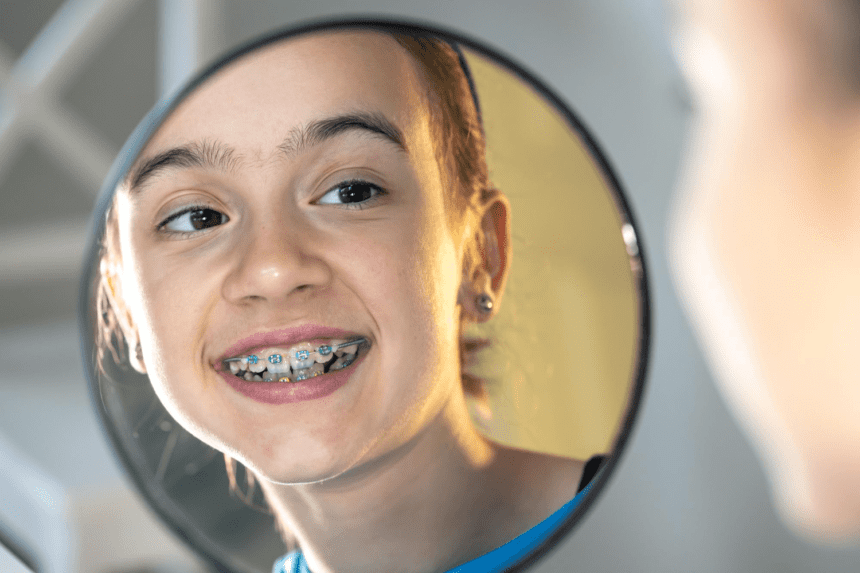Orthodontic treatments improve appearance while correcting difficulties such as misaligned teeth, overcrowding, and bite disorders. In this blog, we are going to discuss Dental Braces explained by the Best Orthodontic Clinic in Deira.
What are Dental Braces?
Dental Braces
Dental braces are used by orthodontists for various orthodontic treatments, including uneven or overbite teeth treatment.
In the past, dental braces were less noticeable and more hidden, they were made from ceramic, plastic, and metal.
They can be customized with cheerful faces and come in fixed or removable types, allowing patients to discard them as needed.
Types of Dental Braces
1. Metal braces
Metal braces gradually move teeth by using wires, brackets, and bands made of stainless steel. They are fastened using ligatures, which can be transparent, tooth-hued, or vibrantly coloured for a fun appearance. Dentists and orthodontists bond them together.
2. Ceramic braces
Ceramic braces blend in with the grin, making them less apparent, but they are more brittle and more prone to breaking than metal braces.
3. Lingual braces
Lingual braces, like standard braces, are employed to hide braces on the back surfaces of teeth so that people do not notice their existence.
4. Self-ligating braces
Self-ligating braces resemble standard metal braces. In contrast to ligatures, which are tiny elastic bands, self-ligating braces have a mechanism built in to secure the archwire in place.
5. Aligners
Aligners, thin plastic trays used in dental therapy, gradually shift teeth during therapy, created using digital scans or mouth molds, and are worn frequently for feeding or brushing.
Dental Retainers and Night Retainers
Dental Retainers
A teeth retainer is a personalized device that you wear over your teeth. It helps you retain your teeth in their new, correct position shortly after braces. Fixed and removable retainers are two kinds of dental retainers. You can buy dental retainers online.
Night Retainers
Patients with a habit of grinding their teeth wear night guards to protect their teeth while sleeping. A dentist may prescribe them to treat damaged teeth, painful jaw muscles, or bone damage. They can be purchased over the counter or custom-made, and they differ from retainers in their purpose and duration of use.
Space retainers
Space retainers are devices used in children with permanent teeth who lost their baby teeth to maintain adult teeth space and prevent nearby baby teeth from occupying the empty space.
Procedure for installing Dental Braces: Explained by the Best Orthodontic Clinic in Deira.
1. The braces are initially placed on the teeth using brackets, an arch wire, and, in some cases, ring-like bands that keep them in place.
2. Periodically, the brace is modified to attain the proper alignment of teeth.
3. Following an adjustment or tightening, your mouth may be painful for a few days.
4. After braces are removed, a retainer is used to keep the teeth stable.
Benefits and Drawbacks of Dental Braces, explained by the Best Orthodontic Clinic in Deira
Benefits
1. Braces straighten teeth, improve gum health, make brushing, cleaning, and flossing simpler, promote oral hygiene, and help prevent periodontal disease and tooth decay.
2. Misaligned teeth prevent effective food chewing and digestion. Braces correct teeth, allowing for better food digestion and chewing.
3. When germs eat away at bones, misaligned teeth can cause bone loss and tooth erosion. Braces straighten teeth and prevent deterioration.
4. Braces promote health, boost confidence, and align teeth, decreasing discomfort and anxiety related to crooked teeth. They also improve face proportions, jawlines, and lips.
Drawbacks
1. Temporary aches and discomforts caused by dental sensitivity may include irritations, tongue problems, increased saliva production, sensitive teeth, and trouble eating or speaking.
2. There is an adjustment period to be adjusted to your braces. In the beginning, it is painful, but later, it becomes normal. Pain may arise in the beginning, but it is swiftly slowed with pain relievers.
3. The correction lasts at least two years and can result in tongue injury, speech impairment, and feeding difficulties.
Conclusion
In conclusion, dental braces play pivotal roles in correcting misalignments and enhancing oral health. While they may entail temporary discomforts, the long-term benefits, including improved confidence and overall well-being, outweigh the challenges. Choose the best orthodontics, which can lead to a healthier, more confident smile.


Leave a Reply